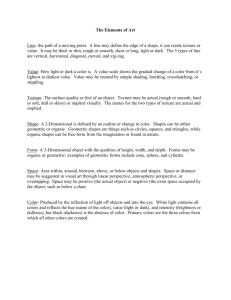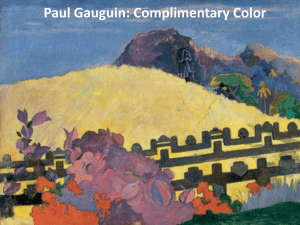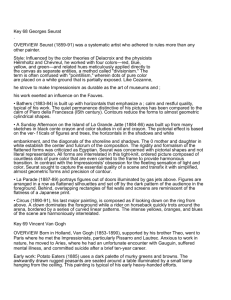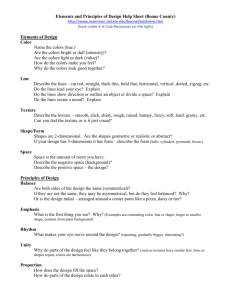138-150
advertisement
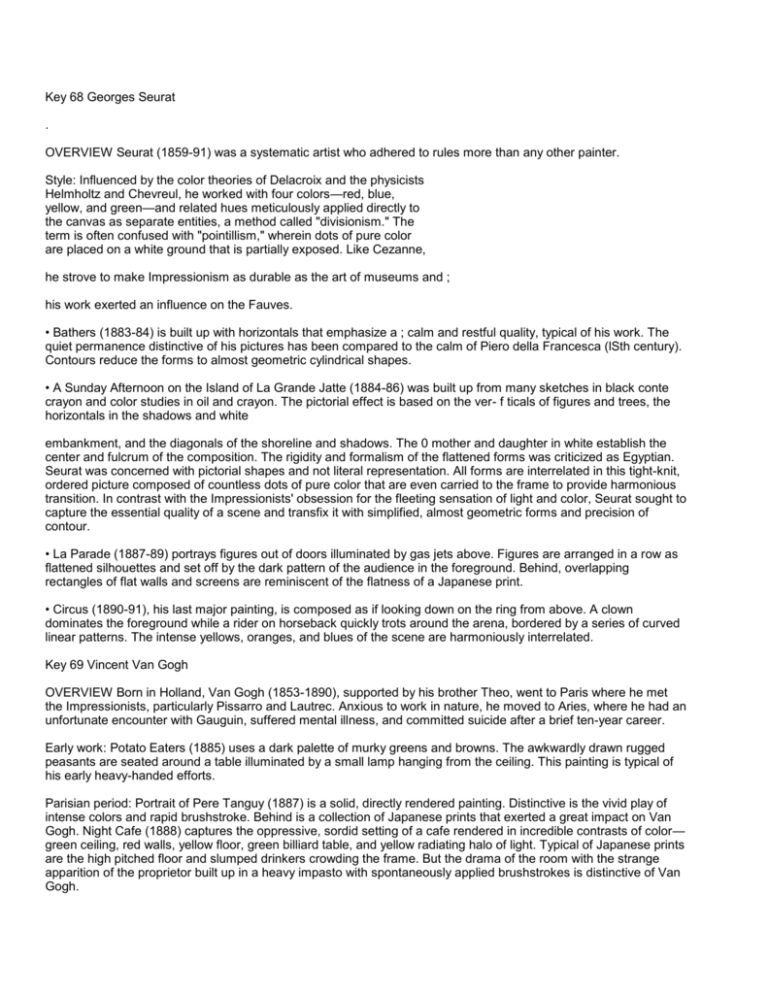
Key 68 Georges Seurat . OVERVIEW Seurat (1859-91) was a systematic artist who adhered to rules more than any other painter. Style: Influenced by the color theories of Delacroix and the physicists Helmholtz and Chevreul, he worked with four colors—red, blue, yellow, and green—and related hues meticulously applied directly to the canvas as separate entities, a method called "divisionism." The term is often confused with "pointillism," wherein dots of pure color are placed on a white ground that is partially exposed. Like Cezanne, he strove to make Impressionism as durable as the art of museums and ; his work exerted an influence on the Fauves. • Bathers (1883-84) is built up with horizontals that emphasize a ; calm and restful quality, typical of his work. The quiet permanence distinctive of his pictures has been compared to the calm of Piero della Francesca (lSth century). Contours reduce the forms to almost geometric cylindrical shapes. • A Sunday Afternoon on the Island of La Grande Jatte (1884-86) was built up from many sketches in black conte crayon and color studies in oil and crayon. The pictorial effect is based on the ver- f ticals of figures and trees, the horizontals in the shadows and white embankment, and the diagonals of the shoreline and shadows. The 0 mother and daughter in white establish the center and fulcrum of the composition. The rigidity and formalism of the flattened forms was criticized as Egyptian. Seurat was concerned with pictorial shapes and not literal representation. All forms are interrelated in this tight-knit, ordered picture composed of countless dots of pure color that are even carried to the frame to provide harmonious transition. In contrast with the Impressionists' obsession for the fleeting sensation of light and color, Seurat sought to capture the essential quality of a scene and transfix it with simplified, almost geometric forms and precision of contour. • La Parade (1887-89) portrays figures out of doors illuminated by gas jets above. Figures are arranged in a row as flattened silhouettes and set off by the dark pattern of the audience in the foreground. Behind, overlapping rectangles of flat walls and screens are reminiscent of the flatness of a Japanese print. • Circus (1890-91), his last major painting, is composed as if looking down on the ring from above. A clown dominates the foreground while a rider on horseback quickly trots around the arena, bordered by a series of curved linear patterns. The intense yellows, oranges, and blues of the scene are harmoniously interrelated. Key 69 Vincent Van Gogh OVERVIEW Born in Holland, Van Gogh (1853-1890), supported by his brother Theo, went to Paris where he met the Impressionists, particularly Pissarro and Lautrec. Anxious to work in nature, he moved to Aries, where he had an unfortunate encounter with Gauguin, suffered mental illness, and committed suicide after a brief ten-year career. Early work: Potato Eaters (1885) uses a dark palette of murky greens and browns. The awkwardly drawn rugged peasants are seated around a table illuminated by a small lamp hanging from the ceiling. This painting is typical of his early heavy-handed efforts. Parisian period: Portrait of Pere Tanguy (1887) is a solid, directly rendered painting. Distinctive is the vivid play of intense colors and rapid brushstroke. Behind is a collection of Japanese prints that exerted a great impact on Van Gogh. Night Cafe (1888) captures the oppressive, sordid setting of a cafe rendered in incredible contrasts of color— green ceiling, red walls, yellow floor, green billiard table, and yellow radiating halo of light. Typical of Japanese prints are the high pitched floor and slumped drinkers crowding the frame. But the drama of the room with the strange apparition of the proprietor built up in a heavy impasto with spontaneously applied brushstrokes is distinctive of Van Gogh. Provence: He came to this southern French city in 1888 and was overwhelmed by the brilliant sunlight of the countryside. He painted the sun-illuminated region with an explosive yellow applied thickly on the canvas in violent brushstrokes. Sometimes he even squeezed the color directly from the tubes onto the surface. Entrance to the Public Garden at Aries (1888) has the Japanese high-pitched composition, bold, directly defined figures, and vibrant colors. Saint Remy: While an inmate at the asylum, he painted Starry Night (1889). Whirling and exploding stars and galaxies threaten the village below while a mysterious flame-like cypress tree surges up at the left. Color became a force that expressed emotions and feverish visions. Auvers: Crows over the Wheatfields (1890) was one of his last paintings. A road boldly cuts through the fiery yellow wheat fields. Above is a vibrating greenish-blue sky with black silhouetted birds. Churning, swirling brushstrokes create a maelstrom on the surface. . Key 70 Paul Gauguin . OVERVIEW Gauguin (1848-1903), a stockbroker in Paris, met and bought the work of Impressionists, particularly Pissarro. Soon he gave up business for art and worked in Brittany, Aries, Tahiti and the Marquesas Islands where he died. Gauguin rebelled against both the European artistic tradition and civilization. Earb work: In Brittany at Pont-Aven and Paulder he painted solid Impressionist landscapes and Breton people. He became the center of a group of artists interested in intense color, flattened form, and dark outlines. Gauguin pursued a subjective expression and attacked the Impressionists because they "neglect the mysterious centers of thought. " • Jacob Wrestling with the Angel (1888) exemplifies his personal approach in the flaming red ground and the flat patterns of Breton women in black and white watching the wrestling figures. The dramatic diagonal of a tree trunk divides the composition of flattened forms and simplified patterns. • Self Portrait with Halo (1889) shows Gauguin as a large man— actually he was short. The flattened composition, linear patterns, art nouveau motif terminating in a snake's head, and solid color patterns typify his style. Later work: He created a remarkable series of decorative canvases based on the colon of the tropics. • Spirit of the Dead Watching (1892) uses flattened, sombre colon with the suggestive volume of a nude girl on the bed. In this and other works, he inscribed the title above in the native language. The scene refen to his native wife, who was terrified by the darkness. • La Orana Maria (1891), a native woman and her son, suggests the Virgin and Child; the two adoring women in the background were taken from the relief of a Japanese temple known to him in a photograph. • L'Appel (1902) is distinctive for its rich harmonious colors, monumental drawing, and strong modeling. The high tilted perspective gives a tapestry effect to the design. Gauguin freed art from descriptive story telling to create an art of expressive color. He wrote, "Everything must be sacrificed to pure color. ..the intensity of the color indicates its nature." • Where Do We Come From? Who Are We? Where Are We Going? one of his last works, was a huge mural that served as a monument after his death. In a vast landscape, standing and seated figures— some borrowed from his other paintings—are self-contained and unrelated to one another (as in Puvis de Chevannes' murals). The flat patterns, bold color, subjective expressions of figures, and purely personal style distinguish this work. Woodcuts: Gauguin made a number of woodcuts and threedimensional carvings that conform to the style and objective of his paintings. Key 71 Henri Rousseau f OVERVIEW A self-taught "Sunday painter," Rousseau | (1844-1910) worked as a customs of Jicial and was known as X Le. Dounier. Because of his unconcern with realistic forms M and perspective, his art has been called Primitive. i Early work: Rousseau fint signed his pictures in 1880 and exhibited 3 with the Independents starting in 1886. • A Carnival Evening (1886) has two figures in white costumes within a winter landscape that exemplifies the fantasy of a stage- < set. Distinctive are the careful outlines, smooth surfaces, intricate detail, compressed space, and combination of reality and unreality. His dream world has a poetic and descriptive quality. Later work: His naive, innocent, humorous style caught the attention of modern artists like Picasso. • The Wedding (1904-5) is one of his most famous works. The : figures, who are unidentified, have individualized faces and stand as motionless cut-outs on the same plane defined by flat outlines. The group is enhanced by colorful background trees and a humorous dog seated in the foreground. • Football Players (1908) is perhaps his only work to depict animation. The composition is laid out as a Saint Andrews cross, and the four player with stereotyped features wear brightly colored striped costumes and socks. The field is framed by small trees. The rugby match is a charming, humorous fantasy. • Artillery Men (1893-95) is a carefully constructed work probably inspired by a photograph. The curved arrangement of the soldiers is echoed by the cluster of trees behind them. Black tunics are marked with color accents and their feet have been painted, then covered with the green of grass—typical of his style. • Jungle pictures like The Dream (1910) were based on his visits to the zoo, botanical gardens, postcards and photography, and his own vivid imagination. Within a luxuriant profusion of trees and flatly rendered leaves is a red couch with a reclining nude; behind is a snake charmer and lions peering out from the foliage. The exotic, otherworldly, dream-like quality anticipates Surrealism. • Sleeping Gypsy (1897) is particularly Surrealistic. In a desert is a sleeping gypsy dressed in a striped robe with a mandolin and vase nearby; over him stands a lion. Beyond stretches a barren landscape with distant hills, and above is a full moon in a blue starry sky. The whole painting conveys a curious, trancelike mood. Use Key 72 Paul Cezanne OVERVIEW A major revolutionary artist, Cetzanne (1839-1906) set the stage for 20th century art and exerted a great impact on the cubists, Fauves, and abstract Expressionists. Sble: He began as an Impressionist but wanted to make of Impressionism, "something solid and durable like the art in museums." He replaced the transient effects of light with a steady uniform light, reduced forms to geometrical equivalents (cylinders, spheres, and cones), and modeled in planes of color that served as a unifying and balancing factor. Creating structural and expressive compositions that re-created nature instead of reproducing it and defining the essence of the subject as felt by the artist became the basis of modern art. Earb work: Uncle Dominic (1865-67) was modeled in earth colors, with broad vigorous strokes of a palette knife (like Courbet); strong outlines give the figure monumentality. The Black Clock (1869-71) is constructed of vertical and horizontal elements, with heavily modeled forms fitted together as an architectural wall. Impressionist period: House of the Hanged Man (1873) was painted out of doors with heightened colors applied in short patchy strokes to capture the warm sunlight. The balanced formal structure is distinctive of Cezanne. The Sea at L'Estaque (1883-85) has the highpitched horizon of Japanese prints as well as the vast open blue space of the sea. The planes and volumes of foreground forms and misty colors of the background make everything seem to come forward. Later work: Cezanne worked increasingly with geometrical forms and blocks of color to give both a solidity and a two-dimensional feel to his canvases. • Rocks in the Forest of Fontainebleau (1894-98) shows how he modulated the warm and cool colors to create advancing and receding planes. He applied patches of color throughout the surface that served to balance the picture firmly. • Mont Sainte-Victoire, near Aix, became an obsession to Cezanne and he painted it about 60 times from every angle. Scenes of the mountain, painted from 1885 to 1906, dramatically reveal his objectives. The earlier work is marked by deep space with a viaduct and mountain range in the background set off by tall slender trees in the foreground while a curving river flanked by houses fills the middle ground. Forms are modeled in blocks and planes of 133 color. The last work, in 1906, reduces the scene to a patchwork of colors in a strikingly abstract style. Masses of green bear little resemblance to nature, fighter touches of blue and a white sky seeming to hover on the surface and reinforce the two-dimensional character of the canvas. The rich color and exuberant spirit had a decided impact on Expressionist artists. • The Great Bathers (1898-1905) has distorted figures in a land scape. Reduced to geometric forms, they echo the sweeping arched movements of the tall trees within a flattened abstract com position that was the culmination of his work and led to Cub ism. Key 73 Auguste Rodin OVERVIEW Perhaps the greatest sculptor of the 19th century, Rodin (1840-1917) was inspired by Renaissance masters—Donatello and Michelangelo—as well as the Impressionists. Style: A modeler, he worked in wax and clay, emphasizing the unfinished quality of his forms whose rough wrinkled textural surfaces produced changing patterns of reflections comparable to the paintings of Monet. But unlike Monet, Rodin was concerned with feelings, emotions, and psychological states of mind. Age of Bronze (1876): One of his first works, it was also one of the most controversial. The anatomy of the boy was so accurate and convincing that Rodin had to prove it was not a cast from a living model. The twisted anguished pose recalls Michelangelo's Dying Slave. Gates of HeU (1880): Rodin never finished these doors, inspired by Dante's Inferno and Ghiberti's Gates of Paradise (Key 33). They were cast in bronze after his death. Preliminary studies consisted of a swarming mass of figures, varied in scale, arranged in dazzling shifts of direction within an indeterminate composition that shows intense pessimism and anxiety. Tortured, agonized forms are reminiscent of Michelangelo's Last Judgment. • The Thinker was derived from Michelangelo's Jeremiah on the Sistine Ceiling as well as from Medieval images of Adam brooding. The uneven, gouged surface captures the play of light. • The Kiss (1886) was cut from marble, leaving the rough hewn base in contrast with the smooth surfaces of the two figures in a sensuous embrace. The softly rendered, luminous marble surface produces a glowing, Impressionist light around the figures. Burghers of Calais (1886): Commemorating a group of heroic citizens of the 14th century, the group was to be placed at street level so that the viewer participated in the event. Rodin created naturalistic men wearing coarse robes and modeled with animated gestures and tragic faces that reflected the fear of death. Rough hewn, deeply gouged depressions and protuberances catch and reflect the light. Ban (1893-97): The honored writer was portrayed as a monolith wrapped in a robe, and erupting out of the huge bulk of his body was a forceful head with a disturbed, almost disdainful expression. The drastic reduction of form and overpowering presence led to modern sculpture. . Key 74 Symbolists . OVERVIEW Some artists before the turn of the 20th century created haunting, shocking, terrifying and nightmarish visions. Odilon Redon (1840-1916): A painter and graphic artist, he depicted Orpheus in 1903 with upturned face and lyre in a mountain landscape that appears like a richly colored dream. Other images were influenced by Goya, like The Balloon Eye (1882), a series of prints dedicated to Edgar Allan Poe. A single dominant eye, symbolic of God, is transformed into a floating balloon. Redon's aim was, "putting the logic of the visible at the service of the invisible." James Ensor (1860-49): In his huge The Entry of Christ into Brussels (1889), Christ is seen in a street with a mass of masked colorful figures. The Intrigue (1890) shows grotesque, depraved faces of people at a carnival. Edvard Munch (1863-1947): A Norwegian, he came to Paris in 1889 and was influenced by Van Gogh and Gauguin. The Scream (1893) has a figure walking along the seashore with hands pressed to the head in terror, heightened by the reverberating landscape and intense red, yellow, and green background. This powerful Expressionistic work contributed to German Expressionism. Gustav Klimt (1862-1910): He established the Austrian Secessionists, influenced by the earlier Berlin Secessionists. The Kiss ( 1908) is built up of a striking gold gown decorated with geometric mosaic colors and covering an embracing couple. The whole conveys an otherworldly quality. Gustave Moreau (1826-1898): His world of fantasy was inspired by Medieval and exotic themes. In The Apparition (1876), an exotically dressed Salome rears back from the sudden apparition of the bleeding head of St. John. The scene is dramatized by the oriental setting and dark background. The Nabis: Followers of Gauguin called themselves "Nabis," a Hebrew word for "prophet." Their work reveals the influence of the Impressionists and Japanese prints. Edouard Vuillard (1868-1940): His small, domestic scenes, like Interior at L'Etang-la-Ville (1893), were done in Divisionist technique with small touches of bright color in all-over patterns rapidly brushed across the canvas, leaving the white areas as part of the composition. 136 Theme 14 20TH CENTURY ART The tempo of change in the 20th century gained momentum as one "ism" followed another in rapid sequence. The incredible number of "isms" reflected the pluralistic international society. Three major concepts dominated the first half of the century: Expressionism, Abstractionism, and Fantasy. The avant-garde who spearheaded these movements drew their inspiration and forms from the art of prehistoric, primitive, and early cultures in different parts of the world. INDIVIDUAL KEYS IN THIS THEME 75 Expressionism 76 Abstractionism in Paris 77 Abstractionism outside Paris 78 Fantastic art 79 Henri Matisse 80 Pablo Picasso 81 Architecture l Key 75 Expressionism OVERVIEW Artists experimented with media and invented new forms while retaining their uniqueness and individuality. They found in primitive art a spontaneity, energy, and design that affected their expressions. Fauves: Their exhibition in Paris (1905) showed paintings that freed color from descriptive representation and, with bold brush strokes and heavy pigment, made the picture surface a single spatial plane. • Henri Matisse (1869-1954), leader of the Fauves, in Joie de Vivre depicted a group of nudes with flexible, unbroken contours and clashing, strident, arbitrary colors. In Red Studio, floating colorful objects are cast against flat planes of red walls and floor. In Green Stripe, the woman's face is divided by a prominent green stripe; "deliberate disharmonies" and jarring shapes are used for emo tional effect. • Andre Derain's (1880-1954) Pool of London looks down on a cargo ship and small boats in port rendered with violent, clashing colors applied with powerful brush strokes. Die Brucke (The Bridge): Working in Dresden (1905), they were, like the Fauves, captivated by tribal sculpture from Oceania and the Congo. Their paintings were more anguished and pessimistic than those of the Fauves. • Emil Nolde (1867-1956), in Doubting Thomas, depicted the reli gious scene as a barbaric ritual enacted by emaciated figures with mask-like faces and jagged patches of color. • Ernst Ludwig Kirchner (1880-1938), in Masks, portrayed a hang ing cluster of distorted masks with strident colors against a blue background. Berlin Street Scene showed prostitutes and dandies with sense of despair and anxiety. Die Blaue Reiter (Munich): Vassily Kandinsky (1866-1944), the intel lectual Russian lawyer who dominated this group, also served as director of the Bauhaus in Weimer (1922-23). He painted the first purely abstract work in the West on the eve of World War I, Composition Vll. The shapes, forms, and colors in this explosive composition have no equivalent in the natural world. The constantly expanding and contracting space created a subconscious spontaneous expression related to music. • Franz Marc. who formed this movement with Kandinsky, painted Deer in the Wood, where the colors and hues of the animals had symbolic meaning. • Oskar Kokoschka (1886-1980), Austrian, celebrated romantic love in Bride of the Wind, a whirlwind scene of artist and mistress swept above a mountain in ecstatic emotion. • Max Beckman (1884-1950) portrayed scenes of devastation and horror in Germany after World War I, as in Ne Night, an indictment of official cruelty and torture in twisted tortured forms and intense colors. Key 76 Abstractionism in Paris OVERVIEW Cubism reflected new intellectual points of view free from representational convention. Figures and landscapes were reduced to a system of geometric shapes, patterns, lines, angles, and sometimes swirls of color. It paralleled the space-time concepts of physicists and led to non-objectivism . Beginnings: After his Impressionist Blue and Pink periods, Pablo Picasso (1881-1973), painted the revolutionary Les Demoiselles d'Avignon (1907), which marked the beginning of Cubism. The composition is conceived as an independent construction. Space is eliminated as the foreground merges with the background; figures are transformed into flat, angular forms; three heads are adapted from African masks while the others are reminiscent of ancient Iberian sculpture. Analytical Cubism: Developed by Picasso and his colleague Georges Braque (1882-1963), it is characterized by fragmented contours, transparent planes hovering in a shallow space, muted colors, and pyramidal composition, as in Picasso's Accordianist (1911). The figure is presented from several angles in a temporal sequence. Synthetic Cubism: Created by these artists in 1912, it shattered reality. Found materials like newspaper, wallpaper, music sheets, etc., were attached to the surface in bright-colored, overlapping shapes that create an almost relief sculpture, as in The Bottle of Suze. Structural lines and color accents emphasize the surface plane; a striking composition is made out of discarded materials. Picasso: In the delightful Three Musicians (1921), broken shapes of the three figures are filled with flat, bright color that seem to move in the syncopated rhythm of music. On the other hand, Guernica (1937), painted in black, gray, and white, is a powerful indictment of modern totalitarianism. Figures portrayed in violent unexpected contortions communicate the horror of the senseless bombing of a helpless Spanish town. Fernand Leger (1881-1955): He pursued the Cubist revolution in compositions that have the sharp precision of machines, as in The City. He combined fragments of urban life—telephone poles, billboards, robotlike people, and buildings—into a lively colorful design. Marcel Duchamp (1887-1968): In Nude Descending a Staircase (1912) he analyzed the figures into cubist planes to create the effect of movement in a closely spaced series of fragmented elements. Robert Delaunsy: Arguing that "color is form and subject," he believed art should be confined to the rhythmic interplay of contrasting areas of color. Discs: Sun and Moon (1913) was based on a color wheel, and the geometric pattern of colors may have had a symbolic meaning. Key 77 Abstractionism outside Paris OVERVIEW Cubism exerted an impact on artists outside of Paris— Futurists (Milan); De Stijl (Holland), and Suprematists and Constructivists (Russia). Futurists: Following the manifesto of Marinetti, they sought to reconcile man with machines and were fascinated with the speed of engines, automobiles, and airplanes. They attacked traditional Italian art and culture, reduced forms to planes, and composed almost abstract canvases of multiple images that tried to show movement as the motion picture did. • Severini, in Dynamic Hieroglyphic of Bat Tabrain, created swirling rhythms of dancers in brilliantly colored cubist planes. De Stilil: The Dutch painter Piet Mondrian (1872-1944), one of the most radical abstractionists, called his style NeoPlasticism. In Composition with Red, Black, and Yellow (1930) he built up a mathematically precise design of horizontal and vertical black lines on a white canvas with three primary hues that established a harmonious, subtle equilibrium. Suprematism: This movement was represented by Kasimir Malevich (1878-1935), who strove for pure geometric abstraction. Black Square on White Square (1913) aimed at the expression of feeling independent of visual forms; abstraction can go no further than White on White (1918). Malevich believed art was a spiritual activity. Sculpture: Among the sculptors at the turn of the century who were related to Cubism were Maillot (Mediterranean) and Lembruck (Standing Youth), who conceived their forms in geometric terms. • Constantin Brancusi (1876-1957) created highly simplified shapes of universal beauty like The Kiss (1908), block-like slabs of stone with the fewest possible elements, and bronzes like Bird in Space (1927), which suggests a bird's sudden upward sweeping movement. • Raymond Duchamp-Villon in The Great Horse conveys the horse's dynamic power in a twisted geometric design with pistonrod legs. • Umberto Boccioni, a Futurist, portrayed in bronze a dashing human figure, Universal Forms of Continuity in Space (1913), with sweeping aerial turbulence symbolizing the dynamism of modern life. • Henry Moore in Two Forms (1936) created slab-like metamorphic 142 images as mysterious as Stonehenge. A series of recumbent human figures were composed of massive interlocking shapes pierced in an open design. • Tatlin (Russia) designed the model of tower, Monument to the Third International, as a swirling, leaning openwork of steel, wood, and glass in cubic and pyramidal shapes. • Pevsner and Gabo (Russia) created forms out of plastic materials that blended science with art. Torso by Pevsnar in plastic and copper sheeting was composed of precise geometric units. Key 78 Fantastic art OVERVIEW The international Dada and Surrealistic movements best exemplified fantastic art between World War I and II. Dada: A group of intellectuals who escaped to Zurich (in 1915), where they attacked the meaninglessness of war and all forms of cultural standard and artistic activity, and gave themselves this nonsensical name. The movement spread to New York, Paris, Berlin, Cologne and Hanover. • Marcel Duchamp (1887- 1968) was the leading spirit of Dada. His Bride Stripped Bare by Her Bachelors ( 1923) is an abstract image rendered in paint, lead foil, and quicksilver sandwiched between double layers of glass. The work eludes interpretation; possibly it may depict erotic frustration. Duchamp also painted a moustache and goatee on a print of the Mona Lisa and exhibited Ready Mades—a bicycle wheel, snow shovel, and urinal—as art. • Jean Arp (1887-1966) created imaginative, whimsical cardboard cut outs like Mountain Table Anchors Navel (1925). • Schwitters (Hanover) created Merz pictures made of objects from the gutter and trash basket like Merz Picture 19 (1920). Surrealism: Emerging out of Dada, it explored psychic experience and was influenced by Freud. Surrealists strove to uncover the subconscious processes of thought by accidental and automatic effects that offered a new realm of imaginative possibilities to shock the viewer. • Jean Miro revelled in unbridled fantasy. HarZequin's Carnival (1925) is composed of flat, linear, colorful amoeba-like shapes floating in space. • Salvador Dali, under influence of Freud, depicted sexual symbolism and irrational objects defined with remarkable precision, as in The Persistence of Uetnory (1931), in which the wet watches destroy the very idea of time. Soft Construction with Boiled Beans reveals monstrous forms of astonishing power that may have been a premonition of Civil War. • Rene Magritte produced humorous, witty images on the absurdity of everyday life. • Marc Chagall, noted for painting, prints, stained glass and stage designs,was among the artists who pursued the current of fantasy. In Self Portrait with Seven Fingers (1912) he combined Cubist geometry with bright colors and his Russian-Jewish folk tradi 14,~~ tion. • Giorgio De Chirico painted a strange series of barren and menacing cityscapes. The Nostalgia of the Infinite (1914) has a mysterious tower with flags and two figures sunounded by dark, disturb ing shadows. • Paul Klee, who taught at the Bauhaus (1921-31), was interested in the art of children and tribal peoples and depicted lively, poetic fantasies like Dance Monster Atop My Soft Song (1922), in which a weird creature is defined in a thin spontaneous line. . Key 79 Henri Matisse OVERVIEW After Fauvism, Matisse's art took on a more lyrical and structured style in painting, cut-outs, and murals. One of the most sensitive and influential artists of the 20th century, he explored a multitude of directions and his art constantly grew and expanded. MUe Yvonne Landsberg (1914): A series of curved lines swirling around her figure creates a rhythmic movement of form and space. The Piano Lesson (1916): A young boy's face is seen behind a piano placed within a large rectangular structured room that recalls Cubism. Flat planes of rich color are enlivened by a small figure at the led corner balancing an elongated form at the upper right. The linear rhythmic areas stand in contrast with the reduction of forrn. The Moorish series (begun in 1921): These paintings are Impressionistic in the dabs of bright color, but the scenes reflect Matisse's fascination with Islamic art (he visited Morocco in 1911). Representative is Decorative Figure on an Ornamental Background (1927). Seated in a room decorated with delightful Oriental patterns is a strongly modeled and fleshy nude. The Knife Thrower (1947): This is one of a series of cut outs that firmly established the two dimensional surface. This stencil form from the Jazz series consists of flat, bright-colored shapes combined with charming floral motifs. Rosary Chapel (Vence, France, 1948-51): He designed the stained glass windows, murals, tiles, altar, doors, vestments, candlesticks, crucifix, and even the exterior spire, for the Dominican nuns. Instead of using traditional religious imagery, he created a colorful, joyous design in glass that bathed the interior in an enchanting yellow, blue, and green light. The murals, on the other hand, are devoid of color; their black and white represents the Dominican Order. Zulma (1950): One of many such works executed when the artist was confined to his bed, it was made of gouache on cut and pasted papers in blue, green, and pink. The precise contours and flat patterns have a spontaneous, vibrant energy. Drawings and prints: Matisse produced a multitude of line drawings and prints in a remarkably sensitive, free line that defined the quintessence of the forms with fewest possible elements. His graphics reveal an exquisite, tasteful sensibility. 146 Key 80 Pablo Picasso OVERVIEW The most prolific and versatile artist in Western art, Picasso produced an amazing quality of art in every media, even stage sets. While he explored all directions in the visual arts, he periodically returned to classic forms. The Bather (1922): The heavy, sculptured form is reminiscent of Classicism but reduced to simplified shapes. Woman in White (1923): It conforms to the same Classical idiom in the well-proportioned seated body clothed in a white, thinly brushed gown. Painter and Model (1928): Despite the drastic distortions of the flattened abstract shapes within a geometrically constructed composition, the figures can be discerned. Girl Before a Mirror (1932): Composed as a stained glass composition, the simultaneous views of the girl are derived from Cubism. The geometric patterns of bright colors are stunning, and the inventive imagery has stimulated many controversial interpretations of the underlying meaning. Bullfight (1934): Fascinated by the bullring, Picasso combined it with the Minotaur in a violent and ferocious combat, expressed in abbreviated forms, dynamic distortions, and vibrant, rapidly brushed-in, high-keyed colors. Weeping Woman (1935): A well-dressed woman wearing a decorative hat suddenly collapses into devastating grief. In the distortion of the Cubistically defined facial features, tears, and hand placed against her mouth, Picasso sympathetically and powerfully captured a universal emotional anguish. Cat with Bird (1939): In a premonition of World War II, a large, dark demonic cat with huge claws and glowing eyes tears a helpless bird to pieces. Sculpture: An outstanding, imaginative sculptor, Picasso created many works in all media, such as She Goat (bronze, 1950), a bold, vigorous creature with exaggerated full stomach, thin neck, sturdy feet, large hanging head, and a rough-textured surface that reflects the light. Bathers (bronze, 1957) is a series of abstract forms constructed of pieces of board, broken sticks, broom handles, and discarded picture frame to create a magical power. 147 Graphics: Representatives of his pnnts in an media is the Minotauronachia Series (etchings) that combine the bullfight with the Minotaur. He portrayed violent battles of life and death in dramatic dark and light patterns with direct, intense, and telling lines. Ceramiec: At Vallouris, he produced striking painted ceramics— plates and figural forms. Key 81 Architecture OVERVIEW Twentieth Century architecture was revolutionized by industrial materials andfunctional design. Styles had no precedent in the past. Machines and technology inspired new forms; engineering and technology played a vital role. Art Nouveau: This turn-of-the-century style of decoration was based on sinuous, curvilinear floral patterns combined with a respect of materials. Antonio Gaudi: The foremost architect of Barcelona, he designed the cut stone Casa Mild (1907) apartment house as a malleable structure with freely modeled restless undulations of the facade and roof. Frank Lloyd Wright: His Prairie Houses were designed in the Cubist style, as was Robie House (1909), an asymmetrical, long, low rectangular structure with roofs extended beyond walls, a concealed entrance, open interior space, and an organic relationship of the house to the setting. Kaufrnann House grows out of the setting as cantilevers extend over the waterfall. The structure is designed with sharp, clear lines and planes. International Sble: This 1920s style is defined by regularity in the spacing of clear, cubic units, lack of decoration, and an austere geometry based on a steel and concrete skeletal structure. • Walter Gropius's Bauhaus at Dessau consists of three major blocks of rooms and studios connected by a bridge; walls are a continuous surface of glass. • Gerrit Rietveldt in Schroeder House (1924), created sweeping planes, overhanging roofs, and rectalinear shapes free of ornament. • Meis Van Der Rohe designed the Luke Shore Apart nents (Chicago) as a luminous cage of glass with exquisite subtlety of proportions. • Charles Le Corbusier's Savoy House, a low square box resting on stilts of reinforced concrete (calledpilofis) became a "machine for living." The Unite de Habitation (1947-52) was supported on pillars and the apartments designed with richly painted screen louvres and balconies. Church of Notre Dame do Haut soars as a curvilinear fortress on the crest of a mountain; small stained glass windows create a magic, spiritual light. Later stales: Technology and new materials contributed to new designs. • Frank Lloyd Wright's Guggenheim Museum rejected the International Style in its expansive cylindrical shape, 90-foot-high spiraling interior, and bold monumental design. • Buckminster Fuller pioneered prefabricated planned units of polyhedra elements that could be built of almost any material at low cost. His geodesic domes roofed the vast space of American Pavilion at the Expo '67 in Montreal. • Louis Kahn in The Center of British Art at Yale University created an imaginative poetic form and pervasive calm interior. • I.M. Pei's National Gallery addition was designed as an aggregation of angular masses on an irregular site with a vast spacious courtyard. • Piano and Roger's Pompidou Center, Paris, was a most exciting original design that emulated a Gothic cathedral in exoskeletons. Metal supports on the exterior and functional interior elements were brightly painted.

